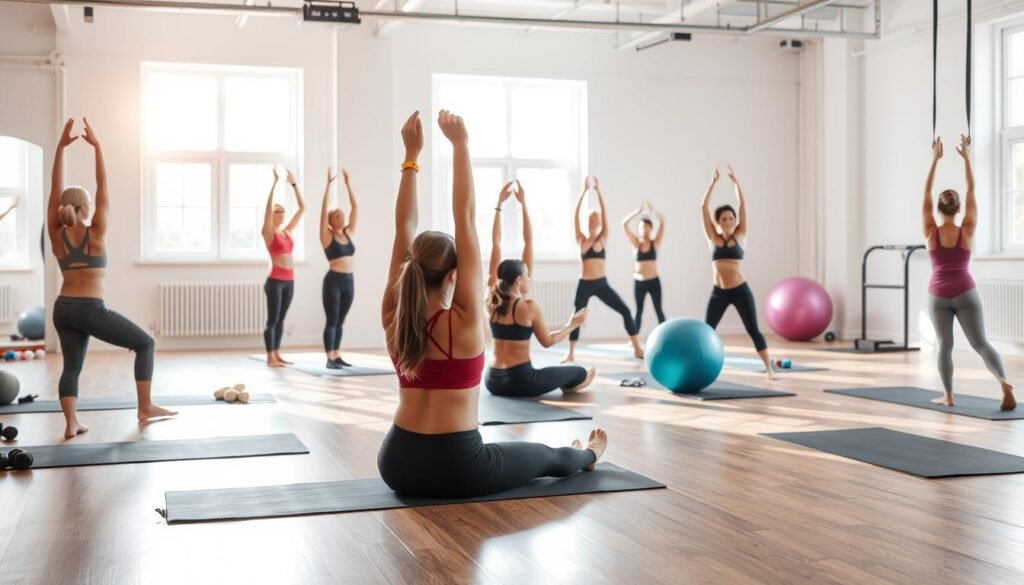
Hypopressive Training: Strengthen Your Core
Hypopressive training is a method that strengthens your core muscles. It uses specific breathing techniques and exercises. This can improve your posture and overall core strength.
This approach supports the pelvic floor and abdominal wall. It helps in better posture correction. Adding hypopressive training to your fitness routine can improve your core and posture.
Hypopressive training is great for any fitness program. It improves posture, enhances core strength, and boosts overall fitness. Its focus on breathing and exercises makes it unique for strengthening the core and correcting posture.
Key Takeaways
- Hypopressive training strengthens core muscles through specific breathing techniques and exercises.
- Improved posture correction is a key benefit of hypopressive training.
- Core strengthening is enhanced through hypopressive training exercises.
- Hypopressive training supports the pelvic floor and abdominal wall.
- Incorporating hypopressive training into your fitness routine can promote overall physical fitness and health.
- Hypopressive training offers a unique approach to core strengthening and posture correction.
What is Hypopressive Training?
Hypopressive training is a special way to exercise that uses breathing techniques and abdominal support. It strengthens the core and boosts physical fitness. This method includes hypopressive exercises that work the deep abdominal muscles. It helps improve posture, balance, and stability.
The core idea of hypopressive training is to make a vacuum in the belly. This strengthens the transverse abdominis muscle. You do this with slow, deep breaths and precise movements. Adding hypopressive exercises to your routine can greatly improve your core strength, flexibility, and athletic performance.
- Improved abdominal support and core strength
- Enhanced breathing techniques for better respiratory function
- Increased flexibility and range of motion
- Reduced risk of injury and improved overall physical fitness
Definition and Overview
Hypopressive training is a complete fitness approach. It focuses on breathing techniques and abdominal support for top physical fitness. By adding hypopressive exercises to your workouts, you’ll see big health and well-being gains.
| Benefits | Description |
|---|---|
| Core Strength | Improved abdominal support and core strength |
| Breathing Techniques | Enhanced respiratory function and overall fitness |
| Flexibility | Increased range of motion and reduced risk of injury |
The Science Behind Hypopressive Exercises
Hypopressive exercises are based on a deep understanding of the body’s anatomy and physiology. They focus on pelvic floor health, which is key to overall well-being. The pelvic floor muscles support the body’s core and help maintain good posture.
Physical therapy helps people become more aware of their body alignment. This awareness can improve posture and pelvic floor health. Adding hypopressive exercises to a physical therapy routine can boost core strength and body alignment.
Anatomical Principles
The anatomical principles of hypopressive exercises focus on the transverse abdominis muscle. This muscle is the deepest abdominal muscle. It’s vital for maintaining good body alignment and supporting the pelvic floor.
Breathing Mechanics
Breathing mechanics are key in hypopressive exercises. They use specific breathing techniques to engage the diaphragm. This promotes efficient breathing and can benefit overall physical therapy and rehabilitation.
Postural Alignment
Good postural alignment is essential for pelvic floor health and physical fitness. Hypopressive exercises help improve body awareness and posture. This reduces injury risk and promotes overall well-being.
| Benefits of Hypopressive Exercises | Description |
|---|---|
| Improved Pelvic Floor Health | Strengthening of the pelvic floor muscles |
| Enhanced Body Alignment | Improved posture and reduced risk of injury |
| Increased Core Strength | Engagement of the transverse abdominis muscle |
Origins and Development of the Hypopressive Method
The history of hypopressive training started in the 1980s. Marcel Caufriez created the Hypopressive Method. It focuses on strengthening the core by using special breathing and muscle techniques.
The development of hypopressive exercises was shaped by anatomy and breathing. These factors played a big role in its creation.
Research shows the Hypopressive Method works by activating pelvic floor muscles. But, traditional exercises might be better for strengthening them. For more details, check out the origin way blog.
Some important parts of the Hypopressive Method are:
- Reducing intra-abdominal pressure
- Activating pelvic floor muscles
- Improving postural alignment
Understanding the history of hypopressive training and its development is key. It helps see what the method can do and its limits. Knowing its origins helps people decide if it’s right for their fitness goals.
Core Benefits of Hypopressive Training
Hypopressive training boosts your health and wellness. It makes your posture better, strengthens your core, and supports your pelvic floor. These benefits help prevent low back pain and boost your fitness.
Posture Improvement
Doing hypopressive training regularly can make your posture better. It strengthens the muscles that keep your spine straight. This can lower your risk of back pain and improve how you stand and move.
Core Strength Enhancement
Hypopressive training is great for strengthening your core. It targets the muscles in your core, making you more stable and balanced. This can help prevent injuries and improve your sports performance.
Pelvic Floor Support
This training also supports your pelvic floor. This is key for controlling your bladder and preventing issues like incontinence.
Abdominal Wall Recovery
For women who had their stomach muscles separate during pregnancy, hypopressive training can help. It strengthens the muscles and improves your core stability.
To enjoy all the benefits of hypopressive training, make it a regular part of your workout routine. Doing so will help you strengthen your core, improve your posture, and prevent low back pain. It also supports your pelvic floor and aids in abdominal wall recovery.

| Benefits of Hypopressive Training | Description |
|---|---|
| Posture Improvement | Strengthens muscles that support the spine, reducing back pain and improving physical alignment |
| Core Strength Enhancement | Targets core muscles, improving stability, balance, and athletic performance |
| Pelvic Floor Support | Supports the pelvic floor, maintaining good bladder control and preventing issues such as incontinence |
| Abdominal Wall Recovery | Helps strengthen muscles and improve core stability, particular for women who have experienced abdominal separation during pregnancy |
Getting Started with Hypopressive Exercises
If you’re new to hypopressive training, start with beginner hypopressive exercises that strengthen your core. This will help you build a strong base and avoid injuries. It’s important to know the basics and how to add them to your workout routine.
Learning proper breathing and how to stand is key. It helps you use your core muscles right and get the best from your exercises. Here are some tips to begin with hypopressive exercises:
- Start with short sessions and gradually increase duration and intensity
- Focus on proper breathing and postural alignment
- Engage your core muscles and maintain a stable position
As you get better, you can add more challenging exercises to your routine. Always pay attention to your body and adjust your workouts as needed. With regular practice and patience, you’ll see big improvements in your core strength and fitness.
By following these tips, you can safely start hypopressive exercises and see the benefits of core strengthening for beginners. With hard work and dedication, you can reach new heights in your fitness journey.
Essential Breathing Techniques
Proper breathing is key for effective hypopressive training. It helps engage core muscles and boosts physical health. Techniques like diaphragmatic breathing are vital for the best results. They improve posture, strengthen the core, and support the pelvic floor.
Diaphragmatic breathing is a core technique in hypopressive training. It uses the diaphragm for better oxygen and carbon dioxide exchange. To do it, expand your ribcage and let your belly rise when you inhale. Learn more about it at breathing and not breathing techniques.
Other important techniques include vacuum breathing and ribcage expansion. They strengthen core muscles and enhance posture. Here are some key points to remember:
- Diaphragmatic breathing: engage your diaphragm to promote efficient oxygen exchange
- Vacuum breathing: create a vacuum in your abdominal cavity to engage your core muscles
- Ribcage expansion: expand your ribcage to improve your posture and breathing
Proper breathing techniques are essential for achieving optimal results in hypopressive training. By incorporating these techniques into your routine, you can improve your overall physical well-being and enhance your core strength.

Basic Hypopressive Positions
Basic hypopressive positions are key in hypopressive training. This method boosts core strength and stability. It targets muscles like the transverse abdominis, pelvic floor, and diaphragm.
Adding these positions to your workout can better your posture and reduce back pain. It also enhances athletic performance.
Some important basic hypopressive positions are:
- Standing position: This targets the transverse abdominis and pelvic floor. It helps improve posture and reduce back pain.
- Seated position: This focuses on the diaphragm and abdominal muscles. It aids in better breathing and core strength.
- Supine position: This targets the pelvic floor and transverse abdominis. It boosts core strength and stability.
Core strengthening exercises are vital in hypopressive training. Basic hypopressive positions lay the groundwork for these exercises. Mastering these positions can enhance your core strength, reduce injury risk, and improve athletic performance.
Always practice these positions with correct breathing and posture. Consistent effort will lead to better core strength and athletic performance.
Advanced Hypopressive Techniques
For those who have been practicing hypopressives for a while, there are advanced exercises to try. These include standing sequences, floor exercises, and dynamic movements. They are meant to challenge you and improve your core strength and fitness. Adding dynamic core strengthening to your routine can take your practice to new heights.
Some key aspects of advanced hypopressive techniques include:
- Standing sequences, which involve a series of movements that challenge balance and engage the core
- Floor exercises, which target specific muscle groups and improve overall flexibility
- Dynamic movements, which combine strength, flexibility, and coordination to create a complete workout
These exercises need a solid foundation in the basics and a focus on proper form. Mastering them can lead to better fitness and less chance of injury. Always start with caution and get help from a qualified instructor.
Adding advanced hypopressive exercises to your routine can bring many benefits. You’ll see improvements in posture, less back pain, and better overall fitness. Hypopressive training is a unique and effective way to reach your fitness goals, whether you’re new or experienced.

With regular practice and dedication, advanced hypopressive techniques can make your core stronger and more resilient. Focus on proper form and add dynamic core strengthening to your routine. This way, you can enjoy the many benefits of advanced hypopressive exercises.
Safety Considerations and Contraindications
When you start hypopressive training, safety is key. This exercise isn’t for everyone. You should talk to a doctor before starting to check if it’s safe for you.
Think about previous injuries, medical conditions, and physical limitations. For example, people with high blood pressure or heart issues might need to change their workout. Pregnant or postpartum women should also be careful, as it can affect their muscles.
- Recent injuries or surgeries
- Certain medical conditions, such as hernias or osteoporosis
- Pregnancy or postpartum
- Severe respiratory or cardiovascular conditions
Knowing these safety tips and contraindications helps you enjoy hypopressive training safely. It keeps you from getting hurt or facing other problems.
| Condition | Precautions |
|---|---|
| Pregnancy | Modify exercises to avoid putting pressure on the pelvic floor |
| High blood pressure | Avoid intense or strenuous exercises |
| Previous injuries | Consult with a healthcare professional to develop a modified exercise plan |
Integrating Hypopressive Training into Your Fitness Routine
Adding hypopressive training to your fitness routine can be a game-changer. It’s low-impact but packs a punch, focusing on strengthening the core. This helps improve posture, boosts core strength, and supports the pelvic floor. It’s a great way to enhance your fitness.
Here are some tips to get you started:
- Begin with simple hypopressive exercises and move to more challenging ones as you get better
- Use hypopressive training in your warm-up or cool-down to boost flexibility and lower injury risk
- Pair hypopressive exercises with cardio or strength training for a balanced workout
By adding hypopressive training to your routine, you’ll see better core strength, posture, and injury prevention. It’s perfect for anyone, athletes or not, because it’s low-impact. Hypopressive training helps you reach your fitness goals and feel better overall.
Always listen to your body and talk to a healthcare expert before starting any new exercise. With commitment and the right advice, you can make hypopressive training a part of your fitness journey. You’ll enjoy its many benefits.
| Benefits of Hypopressive Training | Description |
|---|---|
| Improved Core Strength | Enhances posture, boosts athletic performance, and reduces injury risk |
| Enhanced Posture | Improves overall posture, reducing back and neck pain |
| Reduced Injury Risk | Strengthening core and pelvic floor muscles reduces risk of injury |
Measuring Progress and Results
When you start hypopressive training, it’s key to track your progress. Tracking progress in hypopressive training helps you see where you’re getting better and make changes. You can do this by measuring core strength, which is a big part of hypopressive training.
To see how you’re doing, you can look at physical signs and how well you perform. Physical signs include:
- Increased core strength
- Improved posture
- Enhanced pelvic floor support
Performance metrics are also important. These can be things like how many times you can do an exercise, how long your workouts last, or how hard you’re working. By checking your progress often, you can tweak your routine to get better results.
By looking at both physical signs and performance, you get a full picture of your hypopressive training progress. Always check your progress and adjust your routine to get the best results.
| Method | Description |
|---|---|
| Physical Indicators | Measure core strength, posture, and pelvic floor support |
| Performance Metrics | Track repetitions, duration, and intensity of workouts |
Common Mistakes to Avoid
When you do hypopressive training, knowing common mistakes is key. Avoiding injury in core exercises is very important. These mistakes include bad breathing, wrong posture, and not warming up enough.
To avoid these errors, focus on the right technique and form. This means using diaphragmatic breathing, engaging your core, and keeping your spine straight. Also, listen to your body and don’t overdo it. Common mistakes in hypopressive training can be skipped by being careful and taking the right steps.
- Inadequate warm-up and cool-down routines
- Poor breathing techniques, such as shallow or forced breathing
- Insufficient engagement of core muscles
- Failure to maintain a neutral spine and proper postural alignment
Knowing these common mistakes and how to avoid them is key for safe and effective hypopressive training. Always focus on proper technique and form. If you’re unsure, don’t hesitate to ask a qualified instructor for help.
| Mistake | Correction |
|---|---|
| Inadequate warm-up | Include 5-10 minutes of light cardio and dynamic stretching |
| Poor breathing technique | Focus on diaphragmatic breathing and practice vacuum breathing exercises |
| Insufficient core engagement | Engage your transverse abdominis muscle and maintain a neutral spine |
Conclusion
Hypopressive training is a special way to strengthen your core. It helps improve your posture, stability, and overall health. This method uses breath control, postural alignment, and muscle engagement to build a strong core.
If you’re an athlete, fitness enthusiast, or just want better posture, hypopressive training is for you. It can change how you feel and move. Learning the breathing techniques and positions will make your core stronger and more balanced.
Keep going with hypopressive training, but be patient and consistent. Your body will get better, and you’ll see improvements in posture and strength. Hypopressive training can make you healthier and more resilient. Start now and see the difference in your core.






